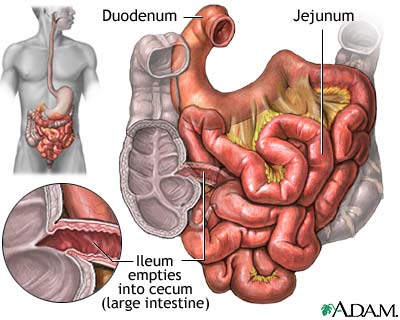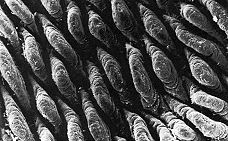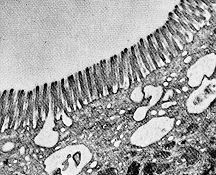Small Intestine: Difference between revisions
No edit summary |
No edit summary |
||
| Line 15: | Line 15: | ||
===Conditions under which the environment changes=== | ===Conditions under which the environment changes=== | ||
Do any of the physical conditions change? Are there chemicals, other organisms, nutrients, etc. that might change the community of your niche. | Do any of the physical conditions change? Are there chemicals, other organisms, nutrients, etc. that might change the community of your niche. | ||
===Subniches=== | |||
====Duodenum==== | |||
[[Image:Villi_em.jpg|frame|Scanning Electron Micrograph of the villi of the small intestine.]] | |||
====Jejunum==== | |||
====Ileum==== | |||
[[image:Microvilli.jpg|frame|Electron Micrograph of the microvilli of a mouse's small intestine]] | |||
==Who lives there?== | ==Who lives there?== | ||
| Line 31: | Line 39: | ||
==Microbial Diseases of the Small Intestine== | ==Microbial Diseases of the Small Intestine== | ||
Revision as of 05:51, 28 August 2008
Introduction
Description of Niche
Where located?
Physical Conditions?
What are the conditions in your niche? Temperature, pressure, pH, moisture, etc.
Influence by Adjacent Communities (if any)
Is your niche close to another niche or influenced by another community of organisms?
Conditions under which the environment changes
Do any of the physical conditions change? Are there chemicals, other organisms, nutrients, etc. that might change the community of your niche.
Subniches
Duodenum
Jejunum
Ileum
Who lives there?
Currently no one :( Boo Radley.
Which microbes are present?
You may refer to organisms by genus or by genus and species, depending upon how detailed the your information might be. If there is already a microbewiki page describing that organism, make a link to it.
Do the microbes that are present interact with each other?
Describe any negative (competition) or positive (symbiosis) behavior
Do the microbes change their environment?
Do they alter pH, attach to surfaces, secrete anything, etc. etc.
Do the microbes carry out any metabolism that affects their environment?
Do they ferment sugars to produce acid, break down large molecules, fix nitrogen, etc. etc.
Microbial Diseases of the Small Intestine
Current Research
Enter summaries of the most recent research. You may find it more appropriate to include this as a subsection under several of your other sections rather than separately here at the end. You should include at least FOUR topics of research and summarize each in terms of the question being asked, the results so far, and the topics for future study. (more will be expected from larger groups than from smaller groups)
References
1 Bentley-Hibbert, Stuart. Small Intestine [The small intestine is the portion of the digestive system most responsible for absorption of nutrients from food into the bloodstream. The pyloric sphincter governs the passage of partly digested food from the stomach into the duodenum. This short first]. Digital image. MedlinePlus Medical Encyclopedia. 25 Oct. 2006. ADAM. 26 Aug. 2008 <http://www.nlm.nih.gov/medlineplus/ency/imagepages/19221.htm>.
JANET'S REFERENCES:
http://www.textbookofbacteriology.net/normalflora.html
Samuel Baron MD; Charles Patrick. Davis (1996). "Bacteriology": Chapter 6. Normal Flora. University of Texas Medical Branch at Galveston.
Sears CL (2005 Oct;11). "A dynamic partnership: celebrating our gut flora". Anaerobe (5):247-51: 247–251. Academic Press.
Edited by [Ellis Chiu, Janet Kwok, Kevin Lee, Susan Lee, Martin Tang, Adnan Vahora], students of Rachel Larsen



